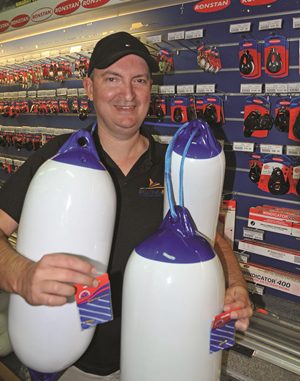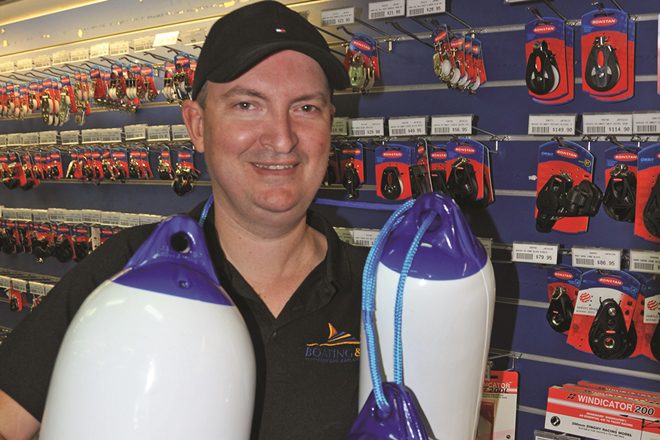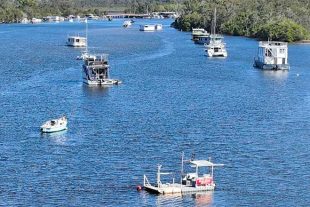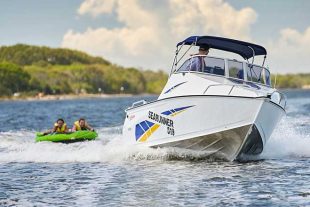 LEADING marine products retailer Boating and RV, which has stores at Capalaba, Slacks Creek, Tingalpa and Townsville, has joined with Bush ‘n Beach to bring you a regular column with some serious information and news about general boating products.
LEADING marine products retailer Boating and RV, which has stores at Capalaba, Slacks Creek, Tingalpa and Townsville, has joined with Bush ‘n Beach to bring you a regular column with some serious information and news about general boating products.
Here, director Aaron Hunt looks at boat fenders, what’s available, why you should have a couple and how some of them can be resurrected once they fail. All powerboats, whether a well-used 4m tinnie showing the ravages of time or a brand-new luxury cruiser, should have an appropriate set of fenders.
For the tinnie owner, the fenders might be a couple of entry level, flat-sided pads that double as cushions on top of the cross thwarts. The cruiser will have a set of fenders that are far larger and more robust to suit its requirements.
The argument: “My boat is just a cheapie – you’d never know if it got a few more bashes, so there’s no need for fenders,” just does not stack up. OK, so what about the damage your boat might cause to another vessel when it’s tied up to the pontoon?
What about providing some extra ‘give’ so a larger boat does not compress your small tinnie against a wharf when you’ve tied up? Do you know how to use a fender to help retrieve a boat in a tight situation with a strong crosswind and run-in tide? For example, when you are retrieving at the Bray Park boat ramp at Boyne Island, south of Gladstone, you will find a beaut floating pontoon with the ramp right next to its northern side.
But with a fast-flowing, big incoming tide and a strong northerly, it can be difficult retrieving your boat back onto the trailer. The conditions can be so strong that at times it is very difficult to push a boat away from the pontoon. At times like that, having a couple of fenders over the port side of your boat as you come into the pontoon can be of great assistance.
Leave them wedged between the pontoon and your boat while you head up to collect your trailer. Reverse your trailer down as close to the pontoon as possible and then use your fenders as side rollers against the pontoon to help you get the boat started up the first couple of rollers on the trailer.
Despite not being designed for the purpose, some fenders also can provide a helpful level of flotation should things go pear-shaped. Considering that an entry-level fender measuring 390mm is typically well under $20, it could be a life-saving investment one day, despite the fact you probably should have been wearing your life jacket anyway.
For larger vessels, the logic is simple. All the reasons above and then some additional ones such as rafting up next to other boats or when sharing a swing mooring, which sometimes happens at diving locations, or when anchoring up for the night next to other vessels at a place like Fitzroy Lagoon.
Majoni cylindrical fenders, manufactured in the Netherlands, are a very popular brand. They’ve been around since the 1950s and represent pretty good quality. Boating and RV stocks Majoni fenders ranging from 450mm in length and 120mm in diameter (for around $20) to the massive 1400mm long and 450mm diameter models (about $180). With more than half a dozen sizes in between, including the often-bought ones of roughly 600mm in length (about $35), they cover the requirements for most recreational trailer boats.
Majoni fenders also have the benefit of having a replaceable inflation valve. Often when a fender goes flat, it is the fault of the inflation valve, rather than a puncturing of the fender body itself. With a Majoni fender, you simply inset a small threaded bolt into the inflation valve, then pull the bolt and valve out of the fender. Unscrew the bolt, then use it to insert a replacement valve.
Other fenders are moulded into the shape of a step such as the Dan-Fender. So, in addition to providing protection between boats as well as between boats and jetties or other fixtures, they can make stepping aboard an easier exercise. They can typically support the weight of a solid adult or around 100kg.
 Bush ‘n Beach Fishing Magazine Location reports & tips for fishing, boating, camping, kayaking, 4WDing in Queensland and Northern NSW
Bush ‘n Beach Fishing Magazine Location reports & tips for fishing, boating, camping, kayaking, 4WDing in Queensland and Northern NSW









